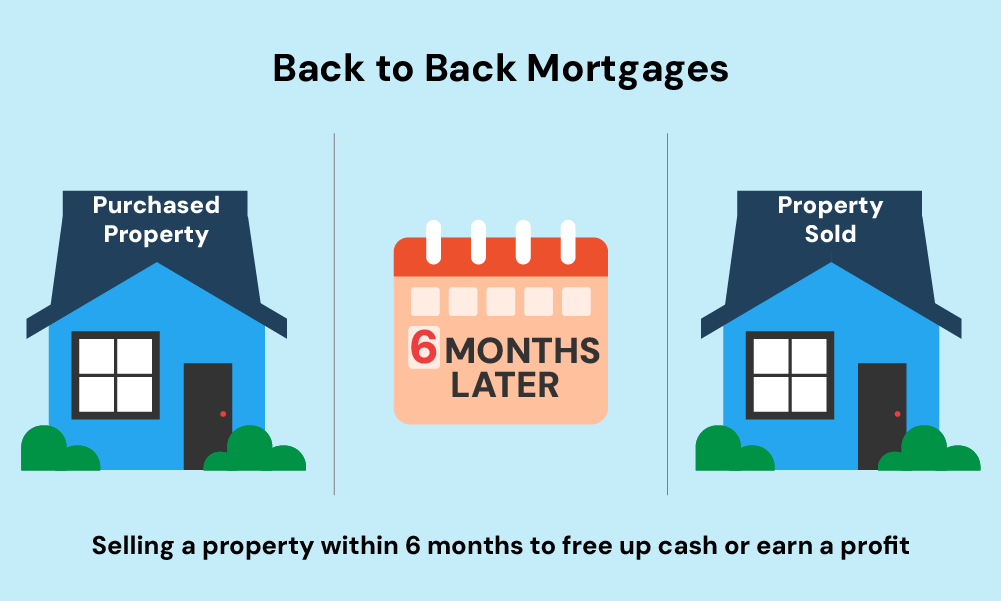What is a Back-to-Back Mortgage? A Guide

A back-to-back mortgage happens when someone sells a property within six months of buying it. This is also known as a sub-sale.
These deals are less common and difficult to arrange as lenders have specific requirements.
Whether you’re an experienced property investor or a first-time buyer, understanding back-to-back mortgages is helpful, especially with the UK’s strict lending rules.
In this article, we’ll explain what a back-to-back mortgage is, why you might need one, and how to make it work for you.
Why Would You Need a Back-to-Back Mortgage?
Life is unpredictable, and sometimes, you need to adapt quickly. A back-to-back mortgage can be a flexible solution in various situations.
Quick Deals
Repossessed homes or auction properties demand speed. If you spot a great deal or need to act fast, a back-to-back mortgage can help you secure the property.
Lenders like Nationwide, Halifax, and NatWest might be more open to these if you have good finances.
Investors looking to flip properties can also benefit.
Bridging the Gap
Need a new home before selling your old one? A bridging loan helps, but converting it to a standard mortgage can be tricky if you bought it recently.
Some lenders will consider it, especially if you need a bridging loan. This works for people downsizing or upsizing quickly too.
Managing Property Changes
Inherited or exchanged homes can be complicated.
A back-to-back mortgage helps manage finances, whether you want to release money or fund renovations. Lenders often prefer these situations as they’re less risky.
Cash and Flexibility
Buying with cash ties up your money. A back-to-back mortgage later can free up cash for investments or unexpected costs. This suits people who want to keep their money liquid.
Life Happens
Job moves, family changes, or financial needs might force a quick sale. A back-to-back mortgage can help you manage this, giving you stability in uncertain times.
Remember, each situation is different. Talking to a mortgage advisor can help you find the best option.

What is the 6-Month Rule in Mortgages?
The so-called “6-month rule” isn’t a strict law but more of a guideline in the UK mortgage market.
The 6-month rule is a guideline, not a strict rule, in the UK mortgage market.
It was introduced after the 2008 financial crisis to prevent risky property flipping.
The idea is that lenders should avoid approving mortgages or remortgages for properties that have changed hands within the last six months.
Why Do Lenders Care About the 6-Month Rule?
Lenders are wary of quick property sales as they can hint at property flipping – buying a property cheaply, improving it slightly, and selling it for a profit quickly.
This is risky for lenders if the property market drops or if the property hasn’t improved.
But don’t panic. The 6-month rule isn’t set in stone.
Many lenders will look at each case separately, especially if you have a good reason for needing a mortgage sooner.
Which Lenders Offer Mortgages Within 6 Months?
Not all lenders are happy to give mortgages on properties sold recently. Some banks and building societies are more flexible than others.
The Big Banks
Nationwide, one of the UK’s biggest mortgage lenders sticks to the 6-month rule but can be flexible in some cases.
For example, they might consider properties you inherited or bought with cash. But they’re usually stricter if you’ve sold a property within six months.
Halifax and NatWest are a bit easier going.
They might approve mortgages for properties sold recently if you have a good reason, like buying a repossessed home or needing money for repairs after buying with cash.
Smaller Lenders
Smaller, specialist lenders are often more open to back-to-back mortgages. They can offer more tailored deals, but you usually need a strong reason for selling the property quickly.
A mortgage broker can help you find the right lender for your situation.

Can You Remortgage After Six Months?
If you’ve just bought a property and are keen to remortgage within six months, you’ve still got options.
While many UK lenders prefer to wait, some will consider it sooner if you meet the right criteria.
To qualify, you’ll need:
- A noticeable increase in your property’s value, possibly due to renovations or a rising market.
- A clean credit history with no missed payments.
- Stable income that shows you can afford the new mortgage terms.
- A low loan-to-value (LTV) ratio, ideally 75% or less.
- A valid reason for remortgaging, like getting a better rate or funding home improvements.
- Proof of funds used for the original purchase, especially if you bought with cash or a bridging loan.
- A lender that’s flexible with the 6-month rule.
If you tick these boxes, you could remortgage sooner than you think.
How Much Can I Remortgage?
The amount you can borrow often depends on the original purchase price, not the current market value. This can limit your options.
If your property has increased in value since you bought it, you might find lenders more willing to remortgage as it reduces their risk.
But, if the property value has dropped, securing favourable terms could be difficult.
How Can You Get a Back-to-Back Mortgage?
Getting a back-to-back mortgage isn’t as simple as a traditional one. It’s a niche type of lending, so you’ll need to take a few smart steps to boost your chances of approval.
Check your credit report.
Before you even think about applying, make sure your financial background is in good shape.
Grab your credit reports and see where you stand. If you spot any issues, now’s the time to fix them.
Work with a specialist broker.
Back-to-back mortgages come with their own set of challenges, and having a broker who knows the ropes can make all the difference.
They’ll guide you through the process, help you gather the right documents, and connect you with lenders who understand your situation.
Gather your documentation.
Lenders will want to know why you need a back-to-back mortgage and will ask for detailed information about the property’s purchase and your finances.
With your broker’s help, make sure you have everything in order to support your application.
Approach lenders with confidence.
With your credit report sorted and a broker by your side, you’re ready to talk to lenders.
Be clear about your situation, provide all the information they need, and be prompt. The more prepared you are, the smoother the process will be.
Should You Get a Back-to-Back Mortgage?
If you’ve got this far, you might be wondering if a back-to-back mortgage is the right move for you.
Let’s break it down simply so you can weigh the pros and cons before making your decision.
Pros:
- Access equity quickly after a cash purchase.
- Secure a mortgage on a repossessed property within six months.
- Convert a bridging loan to a traditional mortgage without waiting.
- Manage inheritance or part-exchange deals smoothly.
- Work with flexible lenders who understand unique circumstances.
Cons:
- Limited lender options available for back-to-back transactions.
- Higher scrutiny and documentation required by lenders.
- Potential restrictions on Loan-to-Value (LTV) ratios.
- Risk of paying higher interest rates due to perceived lender risk.
- The complexity of the process may require a specialist broker.
Key Takeaways
- A back-to-back mortgage is for properties sold within six months of purchase, often used for quick deals like repossessions or auction buys.
- It helps release cash from a property bought outright, convert bridging loans, or manage finances for inherited or part-exchanged homes.
- The 6-month rule discourages quick resales, but some lenders may still consider your application if your situation is justified.
- Success with back-to-back mortgages requires a strong credit profile, detailed documentation, and the guidance of a specialist broker.
The Bottom Line
Back-to-back mortgages aren’t for everyone, but they can be helpful tools for property buyers and investors in certain situations.
Whether you want to raise cash, sell a property quickly, or get a mortgage on a recent purchase, understanding these loans is important.
An experienced mortgage broker can guide you through the complexities of back-to-back mortgages.
They’ll explain your options, find suitable lenders, and negotiate the best deal for you.
Using a broker saves time and effort, and improves your chances of getting the mortgage you need.
Need help? Get in touch, and we’ll connect you with a mortgage broker who understands your situation.
Get Matched With Your Dream Mortgage Advisor...

Frequently asked questions
Can I get a back-to-back mortgage if I used a loan from a relative to buy the property?
Yes, this situation would typically be treated as an original cash purchase by lenders. You might need to provide documentation explaining the source of funds and the nature of the loan.
If I port my existing mortgage to a new property, do I need to stay on a variable rate for six months?
Not necessarily. This would fall under the category of porting, and some lenders may allow you to apply for a new fixed or discounted rate within the 6-month period, depending on your circumstances.




